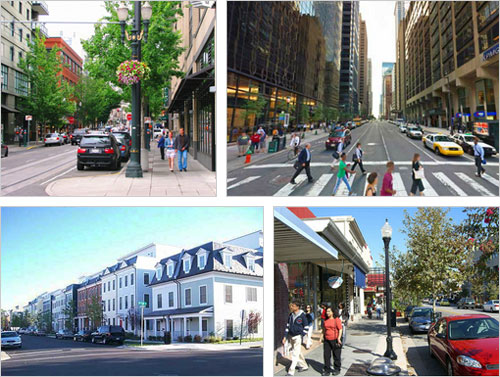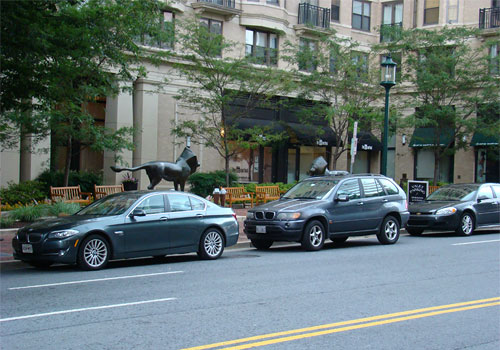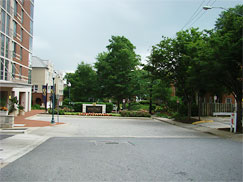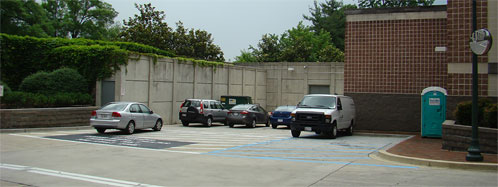Bethesda’s planning survey loads the dice against urbanism
Planners drafting a master plan update for downtown Bethesda are running an online “visual preference” survey to get public input. But the choices they offer — and, even more, the questions they choose not to ask — tilt against the urban style of development that Montgomery County’s most successful downtown needs.

The choices in the survey contrast higher-density streets with one-way traffic (top) with lower-density buildings facing two-way streets (bottom).
The survey compares two patterns of development. One is low-density development with two-way streets; the other, mid-rise and high-rise buildings on one-way streets. But these aren’t the only options. Two-way streets are much more inviting to pedestrians and bicyclists, and there is no reason a dense area can’t have them.
Equally important is what’s left out of the images entirely. A low-rise shopping district, like the one in the lower right of the picture, could never survive in Bethesda on customers who come by Metro from DC. It needs either dense housing and jobs nearby, or lots of parking.
The parking cannot be underground because single-story stores can’t support the expense of underground garages. A realistic picture of low-density retail must include big parking lots or multistory above-ground garages.
Something else is missing from all of the images. Montgomery County zoning requires empty land (known by the Orwellian name of “public use space,” although productive use of the space is banned) next to all mixed-use buildings.

Zoning forced the Lionsgate mixed-use high-rise to include this little-used plaza where busy sidewalk-facing storefronts once stood. Photo by the author.
This rule, fiercely defended by homeowner groups protective of the county’s suburban image, gives us the empty plazas which blight Wisconsin Avenue and are spreading into the Woodmont Triangle. To be accurate, the survey should offer a choice between the attractive streetfront stores in its images and the bleak streetscapes that may emerge if the master plan preserves the status quo in this realm.
Missing entirely from the survey is the relationship between downtown and surrounding neighborhoods. Although most nearby single-family homeowners enjoy their proximity to downtown, neighbors opposed to urbanism often seek to wall themselves off. The connections that emerge from contentious development debates are of widely varying quality.


Three ways Bethesda connects (or doesn’t) to adjoining neighborhoods: the Giant parking lot, the Whitney, and the Chevy Chase Bank building. Photos by the author.
The public should get to choose whether to border downtown with attractive buildings, walkways, and streets, or “buffers” made of walls and parking lots. This choice should not stay hidden, only to emerge later out of closed negotiations between individual builders and the opponents of their projects.
The last page of the survey reveals its authors’ bias once again. There, it asks voters which category they belong to: resident, property owner, development professional, student, or special interest/activist. There are no categories for a regular shopper/diner or office worker.
Nearby homeowners are stakeholders, even if they hate the downtown and never go there. But if you work or shop in Bethesda, you’re off the planners’ radar screen. And never mind the rest of the region, all of which suffers from car traffic that’s made worse by Bethesda’s overly auto-oriented design.

